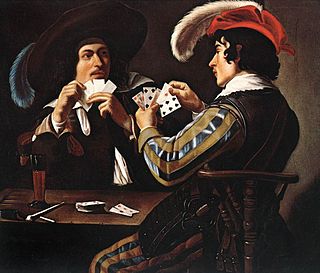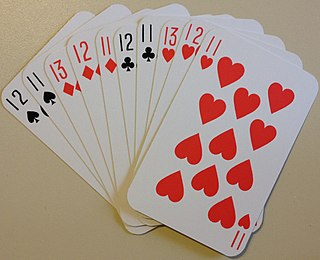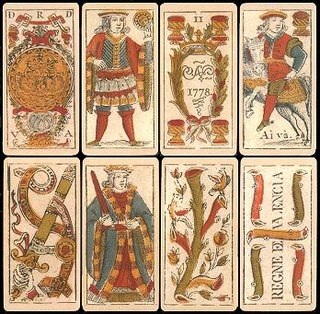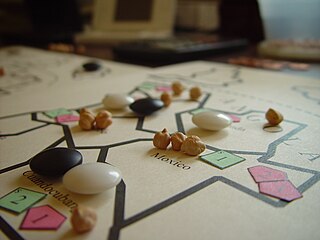Related Research Articles

Contract bridge, or simply bridge, is a trick-taking card game using a standard 52-card deck. In its basic format, it is played by four players in two competing partnerships, with partners sitting opposite each other around a table. Millions of people play bridge worldwide in clubs, tournaments, online and with friends at home, making it one of the world's most popular card games, particularly among seniors. The World Bridge Federation (WBF) is the governing body for international competitive bridge, with numerous other bodies governing it at the regional level.

A card game is any game using playing cards as the primary device with which the game is played, be they traditional or game-specific. Countless card games exist, including families of related games. A small number of card games played with traditional decks have formally standardized rules with international tournaments being held, but most are folk games whose rules may vary by region, culture, location or from circle to circle.
A massively multiplayer online role-playing game (MMORPG) is a video game that combines aspects of a role-playing video game and a massively multiplayer online game.

A role-playing game is a game in which players assume the roles of characters in a fictional setting. Players take responsibility for acting out these roles within a narrative, either through literal acting or through a process of structured decision-making regarding character development. Actions taken within many games succeed or fail according to a formal system of rules and guidelines.

A trick-taking game is a card or tile-based game in which play of a hand centers on a series of finite rounds or units of play, called tricks, which are each evaluated to determine a winner or taker of that trick. The object of such games then may be closely tied to the number of tricks taken, as in plain-trick games such as contract bridge, whist, and spades, or to the value of the cards contained in taken tricks, as in point-trick games such as pinochle, the tarot family, briscola, and most evasion games like hearts. Trick-and-draw games are trick-taking games in which the players can fill up their hands after each trick. In most variants, players are free to play any card into a trick in the first phase of the game, but must follow suit as soon as the stock is depleted. Trick-avoidance games like reversis or polignac are those in which the aim is to avoid taking some or all tricks.

500 or Five Hundred is a trick-taking game developed in the United States from Euchre. Euchre was extended to a 10 card game with bidding and a Misere contract similar to Russian Preference, producing a good cut-throat three player game like Preference and a four player game played in partnerships like Whist which is the most popular modern form, although with special packs it can be played by up to six players. It arose in America before 1900 and was promoted by the US Playing Card Company, who copyrighted and marketed a deck with a set of rules in 1904. The US Playing Card Company released the improved Avondale scoring table to remove bidding irregularities in 1906. 500 is a social card game and was highly popular in the United States until around 1920 when first auction bridge and then contract bridge drove it from favour. It continues to be popular in Ohio and Pennsylvania, where it has been taught through six generations community-wide, and in other countries: Australia, New Zealand, Canada and Shetland. Despite its American origin, 500 is the national card game of Australia.

Skat, historically Scat, is a three-player trick-taking card game of the Ace-Ten family, devised around 1810 in Altenburg in the Duchy of Saxe-Gotha-Altenburg. It is the national game of Germany and, along with Doppelkopf, it is the most popular card game in Germany and Silesia and one of the most popular in the rest of Poland. A variant of 19th-century Skat was once popular in the US. John McLeod considers it one of the best and most interesting card games for three players, and Kelbet described it as "the king of German card games."
In video gaming, camping is a tactic where a player obtains an advantageous static position, which may be a discreet place which is unlikely to be searched. The tactic is employed both in single-player games and online multiplayer games, but is usually more effective in an online multiplayer game, as AI opponents in single-player games may be aware of the player's position, even if they are visually hidden. The tactic varies depending on the type of game. In first-person shooters, it generally involves a player waiting in one location for other players to approach, then killing them before being noticed, or before the other players can react to their presence. By camping, a player is able to learn and adapt to the limited environment they are playing in, noting specific points to check repetitively. By following this method with little fault, a lower number of deaths can be achieved. In other cases, players may wait in an area to gain access to items or perform actions before other players who are not camping have the chance to do so.
In chess, there are a number of ways that a game can end in a draw, neither player winning. Draws are codified by various rules of chess including stalemate, threefold repetition, and the fifty-move rule. Under the standard FIDE rules, a draw also occurs in a dead position, most commonly when neither player has sufficient material to checkmate the opponent.
In trick-taking games, to ruff means to play a trump card to a trick. According to the rules of most games, a player must have no cards left in the suit led in order to ruff. Since the other players are constrained to follow suit if they can, even a low trump can win a trick. In some games, like Pinochle and Preferans, the player who cannot follow suit is required to ruff. In others, like Bridge and Whist, he may instead discard. Normally, ruffing will win a trick. But it is also possible that a subsequent player will overruff. Historically, ruff meant to "rob" i.e. exchange a card with the stock.

Rules of Play: Game Design Fundamentals is a book on game design by Katie Salen and Eric Zimmerman, published by MIT Press.
Accordion is a patience or card solitaire using a single deck of playing cards. It is so named because it looks like accordion pleats, which have to be ironed out. The object is to compress the entire deck into one pile like an accordion.
Aces Up is a quick and simple, one-pack, patience or solitaire card game.
In video games, a level is any space available to the player during the course of completion of an objective. Video game levels generally have progressively increasing difficulty to appeal to players with different skill levels. Each level may present new concepts and challenges to keep a player's interest high.
Permadeath or permanent death is a game mechanic in both tabletop games and video games in which player characters who lose all of their health are considered dead and cannot be used anymore. Depending on the situation, this could require the player to create a new character to continue, or completely restart the game potentially losing nearly all progress made. Other terms include persona death and player death. Some video games offer a hardcore mode that features this mechanic, rather than making it part of the core game.
Switch, also called Two Four Jacks or Irish Switch, or Last Card in New Zealand, is a shedding-type card game for two or more players that is popular in the United Kingdom, Ireland and as alternative incarnations in other regions. The sole aim of Switch is to discard all of the cards in one's hand; the first player to play her, his, or their final card, and ergo have no cards left, wins the game. Switch is very similar to the games UNO, Flaps and Mau Mau, both belonging to the larger Crazy Eights or Shedding family of card games.

A game is a structured form of play, usually undertaken for entertainment or fun, and sometimes used as an educational tool. Many games are also considered to be work or art.

Truc, pronounced [tʁy(k)] in France and [tɾuk] in Spain, is a 15th-century bluff and counter-bluff trick-taking card game which has been likened to poker for two. It is played in Occitania, Sarthe, Poitou (tru) and the Basque Country (truka), and is still very popular in the Valencia region. More elaborate versions are widely played in Argentina, Uruguay, Venezuela, Paraguay and Brazil under such names as Truco, Truque and Truquiflor. The French version Le Truc has become more widely known in the English-speaking world and among hobbyist gamers after Sid Sackson included it in his popular book A Gamut of Games (1969), it being a translation of E. Lanes' 1912 book, Nouveau Manuel Complet des Jeux de Cartes.

Game design is the process of creating and shaping the mechanics, systems, and rules of a game. Games can be created for entertainment, education, exercise, or experimental purposes. Increasingly, elements and principles of game design are also applied to other interactions, in the form of gamification. Game designer and developer Robert Zubek defines game design by breaking it down into its elements, which he says are the following:

In video games, a life is a play-turn that a player character has, defined as the period between start and end of play. Lives refer to a finite number of tries before the game ends with a game over. It is sometimes called a chance, a try, rest or a continue particularly in all-ages games, to avoid the morbid insinuation of losing one's "life". Generally, if the player loses all their health, they lose a life. Losing all lives usually grants the player character "game over", forcing them to either restart or stop playing.
References
- 1 2 Salen, Katie; Zimmerman, Eric (2003), Rules of Play: Game Design Fundamentals, MIT Press, pp. 97–99, ISBN 0-262-24045-9
- 1 2 3 Suits, Bernard (2005), The Grasshopper: Games, Life and Utopia, Broadview Press, pp. 54–55, ISBN 1-55111-772-X